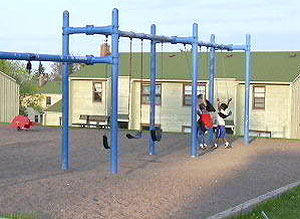|
Audio
Photos
Resources
Your Voice
|
Duluth public housing reborn
June 17, 2003
 |
| Duluth's Harbor View neighborhood carries the stigma of "the projects." Residents say that's about to change. (MPR Photo/Stephanie Hemphill) |
Duluth, Minn. — The Harbor View Homes housing project looks more like an army base than a neighborhood.
On each side of a small playground, identical row houses stare at each other across narrow alleys. Paint is peeling off the plywood siding. Concrete steps are crumbling.
This public housing project is separated from the rest of the city by two busy highways. The city bus doesn't even stop here. The streets are so narrow, the bus had a hard time getting through.
Inside the row houses, the rooms are cramped. They're not handicapped accessible.
 | |||
Craig Tusher lives in a two-bedroom home with his two daughters. He's lived here for 14 years. The small living room is decorated with neatly framed posters of Bob Dylan, the Beatles, and Eric Clapton.
"The frames cost more than the posters," Tusher says. "I wanted to make sure it didn't look like a teenager's room."
Tusher wants each of his teen-aged daughters to have her own room, so he sleeps in the living room. He stores his mattress in a closet during the day.
In the 17-year-old's room, half the space is taken up with a drum set, and the head of the bed is shoved into the closet.
Tusher says a lot of Harbor View residents complain about the bathrooms.
He turns on a noisy exhaust fan.
"That's annoying; a lot of people have that problem," he says. "The tubs, you can't get them clean even though you scrub as much as you want. And the sockets don't always work."
Tusher says sometimes when his daughters invite friends from school to visit, they can't come. Their parents don't want them going to "the projects." Tusher says pretty soon, his daughters won't be labeled based on where they live. Four years from now, this will be a normal Duluth neighborhood, with duplexes, fourplexes, and single family homes. The houses will have porches and some will even have garages.
Starting this fall, all the row houses will be torn down. The work will be done in stages, so everyone won't have to move at once.
 | |||
The new neighborhood will be a mix of renters and homeowners. Some of the homes will be subsidized and others won't. Tusher says he plans to move into one of the new houses. He says it'll make a big difference for his daughters.
"I think it impacts the children in a positive way, to say, 'I'm part of the community of Duluth and the world, I'm not disenfranchised, I'm part of the society, I have all the possibilities that my neighbor has.' And that's a good message for kids to come home to," Tusher says.
That's the whole idea behind this neighborhood renewal. Planners realize the big, isolated public housing projects of the '50s and '60s didn't work, and now they're trying to spread out low-income housing all over the city. It's happening all over the country. The federal government is giving money to cities to help replace old-fashioned housing projects.
There's a lot of competition for the grants. It took Duluth three years to get one.
 | |||
Rick Ball is director of the Housing and Redevelopment Authority in Duluth. He wants to rebuild more than the houses. Some of the people who live here will get jobs doing the rebuilding. Some might even start their own businesses.
"Certainly there's going to be everything from moving to painting to construction trades," Ball says.
Contractors who work on the project must promise to hire Harbor View residents, or other low-income people.
 | |||
And although some people have resisted having low-income housing built in their neighborhoods, Ball says it'll be no problem attracting people to move here.
"It's got the right elements of what we refer to as new urbanism," Ball says. "The idea of creating a village that has recreational opportunities, supportive services, commercial facilities. And it'll have affordable housing, including affordable market-rate housing."
Elderly residents will be able to move into a small apartment building designed with them in mind. The community center will be expanded to include a day care program. And the streets will be wide enough for the city bus to come through.
|
News Headlines
|
Related Subjects
|
